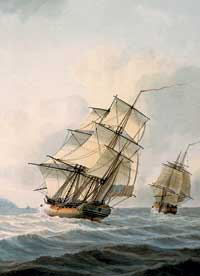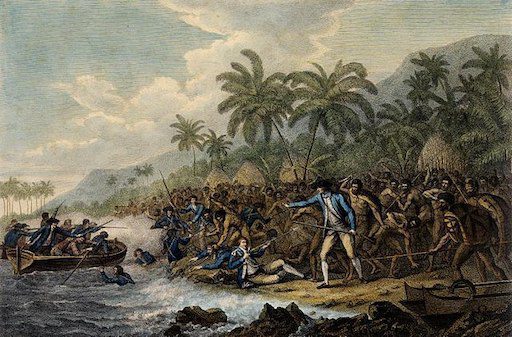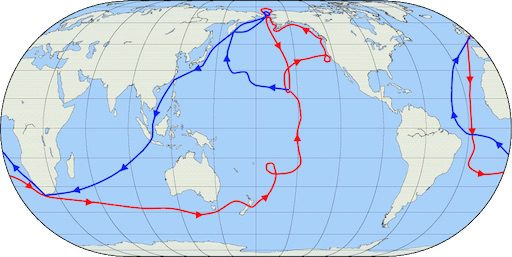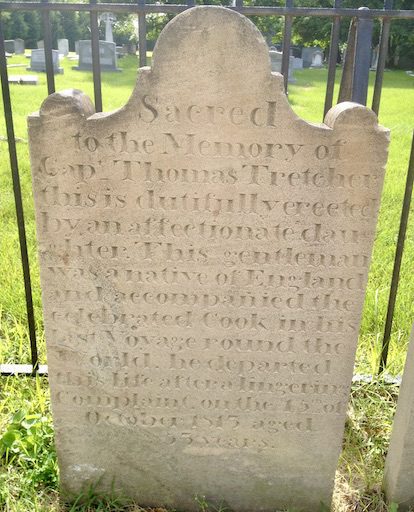In Alexandria’s Presbyterian Cemetery lies Thomas Tretcher (1760 – October 15, 1815), a notable figure with a fascinating history. During his teenage years, Tretcher served as an Able Seaman (AB), a rank above an Ordinary Seaman, on Captain Cook’s Third Voyage, which took place from 1776 to 1780. It was during this momentous expedition that the team discovered the Sandwich Islands, now known as Hawaii.
After his adventurous journey with Captain Cook, Thomas Tretcher pursued a career as a merchant ship’s captain. His seafaring experience and skills likely played a significant role in his successful transition to this leadership position. Eventually, he settled in the charming city of Alexandria.
Throughout his life, Tretcher contributed to maritime commerce and the expansion of trade networks. He became a respected member of the Alexandria community, leaving a lasting impact on the region’s maritime history and development.
Today, his resting place in Alexandria’s Presbyterian Cemetery serves as a reminder of his remarkable journey from a young Able Seaman on Captain Cook’s voyage to becoming a distinguished captain and esteemed resident of Alexandria. His life story stands as a testament to the spirit of adventure and the far-reaching consequences of exploration during the Age of Discovery.
Captain James Cook
Captain James Cook was an esteemed explorer renowned for his significant contributions to the field of Pacific exploration. Prior to his third and final expedition, Cook had already led two successful journeys for The Royal Society, during which he made notable discoveries like Australia and the Antarctic.
In his third expedition, Cook set out to search for the fabled North-West Passage, an ice-free route said to connect the Atlantic and Pacific Oceans. For this expedition, he commanded the “Resolution” ship, while Charles Clerke took charge of the “Discovery.” Among the crew of the Resolution was William Bligh, serving as the ship’s sailing master.
William Bligh later gained his own fame, not always for positive reasons, when he became the captain of HMS Bounty on a Pacific voyage that commenced in 1787. Regrettably, a mutiny occurred on April 28, 1789, during which the crew took control of the Bounty and left Bligh and 18 loyal crew members stranded in an open launch.
Drawing upon the skills and experiences he had acquired from his time voyaging with Captain Cook, Bligh demonstrated exceptional leadership and navigational abilities. Despite the treacherous circumstances, he successfully guided the launch over 3500 nautical miles to safety. Tragically, only one crew member was lost, killed by hostile locals on an island where they had stopped to gather supplies.
Bligh’s remarkable feat of navigation under such dire conditions showcased his resilience and resourcefulness. While the mutiny on the Bounty remains a significant event in maritime history, Bligh’s subsequent journey in the open launch serves as a testament to his remarkable abilities as a sailor and leader.

The Third Expedition
In 1776, Captain James Cook commenced his third and final journey, departing from England with a specific destination in mind: Tahiti. His objective was to return a prominent figure, Omai, to his homeland. Cook had first encountered Omai during his voyage to Tahiti in 1769, and Omai became the second person from the Pacific islands to visit Europe.
Upon their arrival in London in 1774, Omai was granted a unique opportunity to meet King George III on July 17 at Kew Palace. During this meeting, the king presented Omai with money and a ceremonial sword, expressing his admiration and respect for the visitor from distant shores. As a precaution, Omai was also vaccinated against Smallpox, ensuring his safety during his travels.
Omai’s presence in London captivated the imagination of the city’s inhabitants for the subsequent two years. He regaled the curious audience with captivating stories of his homeland and his adventures during his journey to and from the Pacific islands. His firsthand accounts of life in Tahiti and the broader Pacific region fascinated the people of London, offering them a glimpse into a distant and enchanting world.
Omai’s time in London not only enriched the cultural exchange between Europe and the Pacific islands but also left a lasting impression on the people he encountered. His visit became a significant event in the history of cross-cultural interactions, and his stories helped foster an increased interest in exploration and the wider world among the people of London.
According to the Captain Cook Society documents, Tretcher was punished on May 22, 1777, at Lifuka in the Ha`apai Group in the Tonga Islands, where the expedition had stopped during its journey to Tahiti. Captain Charles Clerke mentioned that the punishment was because he let the Indians steal his Boathook. You can read more about it here: [source].
The Death of Cook
Following the departure of Omai in Tahiti on August 12, 1777, Captain James Cook proceeded with his exploration and embarked on a momentous journey. In January 1778, he made a remarkable discovery, stumbling upon the Hawaiian Islands. Prior to this, Cook had already left his mark in Alaska, as he had explored and identified the Bering Strait and Cook Inlet, both of which were subsequently named in his honor.
Tragically, the culmination of Cook’s exploration came with a devastating turn of events. On February 14, 1779, Cook and four British Marines found themselves entangled in a fatal encounter with the Hawaiians at Kealakekua Bay. The incident unfolded when Cook sought to retrieve a small boat that had been taken by the Hawaiians. Tensions escalated, leading to a violent clash between the two groups.
Regrettably, the clash resulted in the loss of Captain Cook’s life and the lives of four of his comrades. The encounter marked a somber ending to Cook’s exploration, leaving behind a legacy of both remarkable discoveries and the price paid for exploring unknown territories.
The death of Captain Cook deeply impacted the course of history, highlighting the complexities and dangers faced by explorers during the Age of Discovery. His voyages and encounters with different cultures left a lasting imprint on the world, shaping further exploration and cross-cultural interactions in the following years.

Following the tragic events at Kealakekua Bay, the expedition’s leadership underwent a change. With Captain Cook’s untimely death, the command of the voyage fell to Captain Charles Clerke. However, during this challenging period, Captain Clerke’s health began to deteriorate due to Tuberculosis.
As Captain Clerke’s condition worsened, it became clear that he could no longer continue leading the expedition. In light of the circumstances and the need for a capable leader, John Gore, who had been a loyal companion of Captain Cook on his previous voyages, stepped in to take over the command.
John Gore assumed the responsibility of leading the remaining crew and the expedition’s vessels. Despite the loss of their esteemed captain, Cook, and the hardships they endured, the expedition continued its mission under the new leadership of Captain Gore. Despite the challenges they faced, the crew persevered, making significant contributions to geographical exploration and scientific knowledge during the voyage.
Captain Gore’s dedication and experience as a seasoned explorer contributed to the success of the expedition’s ongoing exploration of the Pacific and its surrounding regions. The journey continued, marked by Captain Cook’s legacy and Captain Gore’s remarkable leadership in the face of adversity.
Tretcher is lost on Christmas Island.
On December 29, 1779, an incident occurred on Christmas Island, a remote island located south of Indonesia and within the territory of Australia in the Pacific Ocean. Two individuals, Thomas Tretcher and Barthold Lohman, found themselves lost on this isolated island. The island received its name due to its discovery on Christmas Day in 1643.
In the aftermath of their disappearance, a search operation was launched to find the missing explorers. Fortunately, on the following day, December 30th, Thomas Tretcher was located and rescued from the island. However, it took an additional day, until December 31st, for the search party to locate and bring Barthold Lohman (Bartholomew Lowman) to safety.
The incident was a testament to the challenges and risks faced by explorers during their journeys in the Pacific region. The remote and unfamiliar terrain of Christmas Island posed a significant threat to those who traversed its shores. Nonetheless, the successful rescue of both Tretcher and Lohman demonstrated the determination and resourcefulness of their fellow explorers, who worked tirelessly to ensure the safety and well-being of their comrades during this perilous episode.
In the afternoon, the party who had been employed in catching turtle at the south-eastern part of the island, returned on board, except a sailor belonging to Captain Clerke’s ship, who had been missing for two days. At first, there were two men who had lost their way; but happening to disagree with respect to the track that was most likely to bring them to their companions, they had separated; and one of them found means to rejoin the party, after an absence of twenty-four hours, during which he had experienced great distress. There being no fresh water in the whole island, and not one cocoa-nut tree in that part of it, he, in order to allay his thirst had recourse to the extraordinary expedient of drinking the blood of turtle, which he killed for that purpose. His method of refreshing himself, when fatigued, was equally singular, though he said he felt the good effects of it: he undressed himself and lay down in the shallow water on the beach for some time. How these two men had contrived to lose their way, was a matter of astonishment. The land over which their journey lay, from the sea-coast to the lagoon, where the boats were stationed, did not exceed three miles across; nor was there any thing that could impede their view; for the country was level, with a few shrubs dispersed about it; and, from many parts the masts of our vessels could be easily discerned. This, however, was a rule of direction which they did not think of; nor did they recollect in what part of the island the ships lay at anchor and they were totally at a loss how to get back to them, or to the party they had so carelessly straggled from. Considering what strange people the generality of sailors are, while on shore, we might, instead of being much surprized that these two should thus lose themselves, rather wonder that no more of the party were missing. [source].

Marriage, Trading Ship Captain, and Death
After completing their exploration journey, both of Captain Cook’s ships, including the one on which Thomas Tretcher served, returned to England in October 1780. In the years that followed, Tretcher’s life took a new direction. In August 1783, he married Eleanor Taylor, and he began his career as a captain on trading ships. Together, they embarked on numerous voyages, with Eleanor accompanying her husband on these maritime adventures.
Eventually, the couple decided to settle in Alexandria, where they resided near the intersection of King and Royal Street. In their home, they welcomed the birth of their daughter, Elizabeth, in 1795. Elizabeth later married James M. Steuart from the well-known Ramsay family of Alexandria. Their marriage took place on April 13, 1812, at the Presbyterian Meeting House in Alexandria.
Tragedy struck the Tretcher family in the fall of 1815, as both Thomas and his beloved wife, Eleanor, passed away. They departed from this world just three weeks apart. Thomas Tretcher, at the age of 53, succumbed to Tuberculosis, while Eleanor’s life ended due to a “lingering complaint.”
Their legacy lives on, and Eleanor’s gravestone at the Presbyterian Cemetery bears an inscription commemorating her adventurous spirit and devotion to her husband. It notes that she crossed the equator three times alongside Thomas during their voyages. Their lives were intertwined with exploration, adventure, and the maritime world, leaving a lasting impact on the history of Alexandria and beyond.

The Tretcher’s gravestones in the Presbyterian Cemetery and their inscriptions
| Sacred to the memory of Capt Thomas Tretcher this is dutifully erected by an affectionate daughter. This gentleman was a native of England and accompanied the celebrated Cook in his Last Voyage round the World. He departed this life after a lingering Complaint on the 15th of October, 1815 aged 53 years. | Sacred to the memory of Eleanor Tretcher this is dutifully erected by an affectionate daughter. this lady was a native of England and thrice crossed the line with her husband. she departed this life three weeks before him after a short illness on the 24th September 1815 aged 51 years. |
Sources of Information
Pippenger, W. E. (1992). Tombstone Inscriptions of Alexandria, Virginia: Volume 1. Family Line Publications, Westminster, MD, and Heritage Books, Inc., Bowie, MD.
Wright, F. E., & Pippenger, W. E. (2012). Early Church Records of Alexandria City and Fairfax County, Virginia. Heritage Books, Westminister, Maryland.
Roberts, A. (2021). The Last King of America: The Misunderstood Reign of George III. Viking.
Dahmann, D. D. (2022). The roster of Historic Congregational Members of the Old Presbyterian Meeting House. Unpublished.
The Captain Cook Society. (2017). Official Website. [Link].